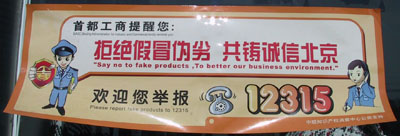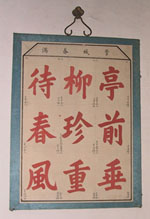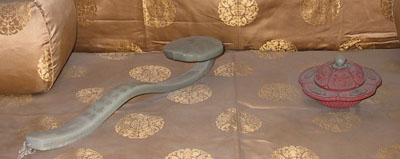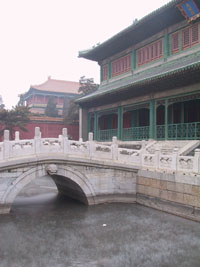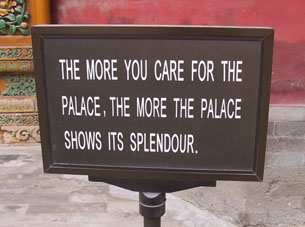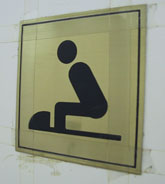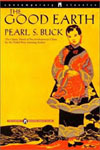Remade in Taiwan
So, a few days into my China trip my laptop died — motherboard fried. You see, my machine prefers to crap out when I am half a globe away from my local tech support, having most recently decided to spin its hard disk platters into the drive armature when I was in Egypt in October. Yeah, I needed that. What’s worse this time is that I had only recently achieved the goal of getting rid of individual power cords for my camera, iPod, and phone, instead charging them all via USB through the laptop. You see where I am going with this, no doubt. With a dead machine, nothing would charge. Single point of failure. Nice design, John. My technology world came crashing down in a single heap of powerless gadgets. And it was a weekend with little hope of tech support in China. How did I manage? My trusty moleskine of course! Eventually on the last day before coming home, some colleagues of mine in Taipei were able to repair my machine with one of only four motherboards for my laptop model on the island. Nicely solved!
A couple of assorted things before this China travelogue comes to an end.
- Cathay Pacific is everything that United as an airline is not. I could get used to that level of service. They even titillate you with onboard e-mail access, but it turns out the e-mail is queued locally on a server and sent out in batches. Not exactly Lufthansa-style in-flight access, but hey, they did treat me like royalty.
- Taipei 101, the current world’s tallest building, has a pressurized express elevator that moves you faster than your inner ear cares to admit. It also has a massive vibration damper tuned to the frequency of the building itself. It is open to public inspection and looks like something straight out of a sci-fi film. Bow down to the spherical power core!
- I never did get sick. My family continued to suffer, though, as a bout of pink eye and double ear infections added themselves to the compendium of maladies that afflicted the already-miserable.
- I ate a caffeinated egg and gelatinous coffee. Not sure which was worse.
Finally, some more polite signage from the Forbidden City. Really, no problem at all.
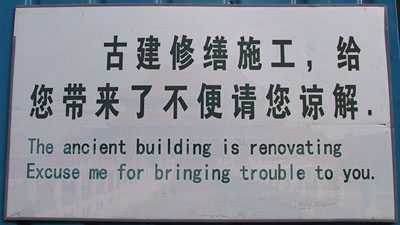
And then this:
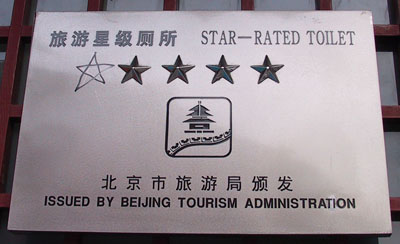
Fine, but everyone knows there’s no such thing as a five-star crapper. Simply ridiculous. The scale just doesn’t go that high.
Replicants
Today I spent many hours of hell braving the Ya Show market in central Beijing. Armed with printouts of fine handbags from my wife I was there to acquire as many name-brand knock-off purses as I could afford and carry back to the hotel without undue strain or attention being drawn. It was misery, since I’m not a big shopper anyway and have no innate sense of what a Prada purse should cost, but I made it out relatively unscathed. Two things made me laugh repeatedly, though. The English of the stall-keepers was uniformly horrible, unless it related directly to the act of selling or keeping you from walking away. Phrases such as “make me a smarter offer” or “where will you find such quality elsewhere?” were syntactically correct and enunciated flawlessly. It was fun to test the boundaries, to probe the limits of vendors who were really just human phrase-recall databases.
Input: potential buyer walking away.
Output: “Sir, please enter your price into my calculator.”
Input: Shopper says “Do you take US dollars?”
Output: “Why yes, sir, as well as RMB and Hong Kong dollars, thank you.”
Input: Shopper says “Excuse me, do you know the closet subway line to the market?”
Output: Blank stare, no keywords triggered. Abort, retry, fail?
The other thing I loved were the signs placed everywhere imploring shoppers to report any fake products. It was all so earnestly ridiculous. There wasn’t anything real in the whole place. (Not that I could have spotted a real Gucci purse, mind you.) Sure, I’ll dial the police right up. Just let me know if the American embassy will pay for my funeral after the shopkeepers — and their customers! — lynch me with so many faux leather belts.
True, in advance of the Olympics and as part of playing nicely with their trading partners, the Chinese authorities are starting to crack down on the product replica business, but I think this may not ultimately be as much an economic practice as a cultural one.
In his fascinating book The Future of the Past, Alexander Stille notes how China and other Asian countries do not consider a copy to be less real or less significant than the original it represents. Like a digital copy of a file that has no more claim to authenticity than its “source” file, high-quality copies in China are consider artforms in their own right. This is borne out in the field of cultural artifact conservation. For the Chinese, copying is conservation, a concept completely foreign to Western conservators. Because most Chinese architecture had traditionally been wood-based (rather than stone-based) there has never been a strong notion of permanence in art. To keep a work of art alive you had to replicate it and, in the process, were showing a reverence for the skill of the artisan that came before you. Still, this approach flies in the face of nearly every precept of Western cultural conservation. Can you imagine the Italians throwing out the David and creating a new, cleaner one as a solution to the recent conversation problems they have had?
It will be a shame if the fake product industry (or the skills upon which it thrives) does not survive in the face of globalization and homogenizing markets. In a way, the closure of the fake product markets is just the latest assault on the “culture of the copy,” as Stille terms it. Just as the Cultural Revolution decimated sites of historical value throughout China — effectively severing the centuries-old artisanal traditions that permitted the cycle of upkeep and re-creation to persist — the closure of markets like the famous Silk Alley represents the triumph of one concept, in this case the inviolability of global trademarks, over another, much older one: the exultation of the replica.
Physicalized words
I can’t read Chinese, though I am able to at least distinguish it from Korean and Japanese scripts. (Cut me some slack, that’s progress! But don’t even ask about distinguishing Traditional from Simplified. I’ll have to be content in my ignorance on that one.) What this means is that, since I have no idea what idea is being conveyed, my growing love for Chinese characters is almost purely visual. A reverse ekphrasis, the strokes of even the most mundane lines are painterly, evocative of an artform more fully engaged with the space around it than Western writing. Chinese calligraphy, such as I have seen it, is more akin to dance or yoga than it is to other scribal arts. It is all very physical.
Consider the “calendar” in the image above. Called the 81 Days of Winter, it is a single phrase that evolves slowly over the course of the winter. Each day the author/painter adds one stroke to the characters; a total of 81 comprise all nine characters. Ticking off the days like an Advent calendar, the phrase is complete by the end of winter:
The weeping willow of the pavillion waits for the warm breath of spring.
But it isn’t just script that is spatialized.
The item on the left is called a Ruyi. Long ago it was an imperial backscratcher, but it eventually lost that function altogether and merely became a royal symbol. The item to the right is a spitoon shaped like a persimmon flower. Together they form a visual pun. The word “ruyi” also means (or sounds like) “whatever you wish” in Chinese. The word for persimmon also means “everything”. So, taken together, the two completely symbolic objects mean “everything you wish for”. You see these objects conspicuously placed together on furniture throughout the Forbidden City, a portmanteau resting amongst the other objects of daily life.
The Pavilion of Literary Profundity
Now that’s the way to name a library! Or, more specifically, a book depository. We braved the bitter cold at the Forbidden City in Beijing for a unique tour of this Ming-era building deep inside the palace complex. It isn’t open to the public as it is still used as storage for what looked like textbooks and promotional materials. Dust clogged the air and draped everything; if I were alone it would have been exceptionally creepy.
The upper floors were empty — much of the original corpus is in the National Palace Museum in Taipei, but they offered close inspection of some fancy stacking technology. (Ever since reading Henry Petroski’s Book on the Bookshelf I’ve had a low-level interest in the technologies of physically storing books.) Each section in the stacks are composed of two-ply shelves. The top shelf is a grid, to allow ample airflow in and around the volumes and scrolls. A second shelf immediately underneath the first is filled with sand. In the event of fire, this shelf would burn through (the theory goes) and dump fire-extinguising sand onto the level below. Rather ingenious.
Those Ming and Qing certainly were committed to fire abatement. Some 300 bronze vats were spread throughout the grounds for ready access to water (heated by fire in winter to keep it liquid). Protection was sought symbolically as well. The roof of the Pavilion of Literary Profundity is colored black, an atypical choice in the Forbidden City, but one that connotes water in the Chinese spectrum. Dragons spew water at the corners of the building and a huge lighting rod and cable snakes across the spine of the roof into the ground. All combined, an admirable long-term data preservation strategy. (More photos at Flickr.)
Forboding signs
I mentioned being disinfected on the approach into China. Maybe I spoke too soon. Turns out my entire family back home has been completely waylaid by some Stephen King strain of influenza. Fevers, painful coughing, locusts, general pestilence — all coming down at once. The disease vector this time was — surprise — my kids. My father-in-law calls children “poison dwarves” and he ain’t kidding. Sometimes I think my son’s school is a front for a biological weapons laboratory.
So here I am on the other side of the planet worrying that a time-release virus is waiting for the most inopportune time to blossom into full-blown misery for me. I’m OK now, but I just know I’m doomed. So I get the name of some potent flu-prevention meds from back home and think, what the hell, I’ll see if I can get them here. I slip the bellboy a note and some RMB and ask him to find me the best Oseltamivir Phosphate he could find. He scurries off and only then does it occur to me that I’m probably going to be hauled off to SARS quarantine or something. Then I recall that the newspapers on the plane mentioned the latest bird flu outbreak in Vietnam and Thailand and the steps China is taking to keep it out. So, if the virus doesn’t get me, the anti-virus police will. Nice going, John. We’ll see what happens tomorrow.
What luck that I should discover that my hotel room is actually outfitted with dual gas masks, should I develop symptoms of influenza (or bird flu!) and not care to infect my co-workers. The best part of these beauties: pop-top lids. Like they should be in the minibar or something.
Here are two of my favorite pieces of signage today. The first is a gem from the Forbidden City in central Beijing. Apparently, it wants to be loved just like everyone else.
And lastly, this pictogram. To many people this says “squat toilet ahead.” To some it says “impossible feats of human levitation ahead.” To most Westerners, however, it simply says “run away, run away fast … and clench!”
ORD -> PEK
Last week I was in China for work. Here’s the first in a series of posts that didn’t quite make it up in real time.
This is my third time to China in the past year, but only my first time doing it via a “normal” route. The first time was by going east from Chicago for work in Europe then continuing onward to the Far East and eastward still across the Pacific home. That was awful. Destroyed me. This past summer because of scheduling conflicts I had to take some godforsaken cattle-hauler out of LA at midnight. How pleased was I to be booked on a direct, non-stop flight from Chicago to Beijing this time!
You know, it still sucked. No matter how you slice it, 14 hours on an airplane is just brutal. And it does not help that United personnel appear to be defending their 2004 title of World’s Snippiest Flight Crews. Man, those people are just bitter. If they were half as chipper as their discount-fare faux persona Ted it would be bearable, but as it is now you feel like you’re imposing on the airline itself just occupying a seat that needs to be served a cold beverage.
Chinese law requires the occupants of inbound airplanes to be disinfected just prior to landing by flight attendants who run up and down the aisles with something like a cannister of Right Guard. But it ain’t deodorant. I don’t know what it is, or what exactly it does, but it is an endearing little welcome ritual. Like we’re being perfumed for entry into the presence of royalty or something.
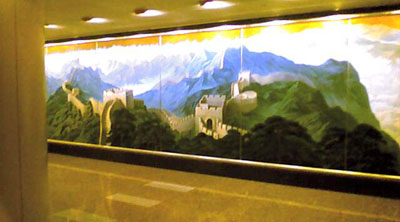
More endearing still, in an odd way, is the mural of the Great Wall painted behind the stalls of the passport control agents that greet you upon arrival. Is it me or is the depiction of a massive rampart meant to keep foreigners out of your country (and ineffectually at that!) the best welcome mat for visitors? Welcome to China … it could be worse.
And the construction cranes! I have never seen quite so many in such density. Yes, I’ve heard that something like 60% of the world’s cranes are in Shanghai right now, but I figured that was exaggeration — probably is. But the Beijing airport is a veritable forest o’ cranes. Perhaps this is where they grow them? Perhaps they are prepping a new terminal for the Airbus A380 flying casino/health club/theater/plane?
One last thing before I nod off. The greeting of guests by name as they walk in the door of the hotel and the escorting of these guests straight to their rooms without stopping at the front desk and the checking in of these guests in the room itself — yes, all that, I love it. Wish all hotels would do that.
The Good Earth
There’s a possibility of upcoming work in China, so I’m trying to get a feel for the history, places, and people. I had read some “Complete History of” titles for the macro sweep view when Pearl Buck’s The Good Earth was released in a new edition. (OK, fine. It was for Oprah’s Book Club. Can I help it that she picked this book too?) It is a deceptively simple book about a farmer who achieves great success through hard work and love for his land while, periperhal to his rural experience, the country heaves and lurches toward revolution. The tale is reminiscent in a way of William Dean Howells’ classic American novel The Rise of Silas Lapham, though Buck’s story is made more powerful by the knowledge of what would happen to China after she wrote the book in 1931. Indeed, the final scene somewhat eerily presages the widespread seizures of land that marked the civil war and Communist rule.
Anybody have any other good titles on Chinese life, history, or politics?

